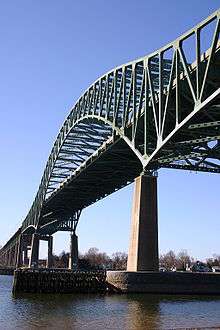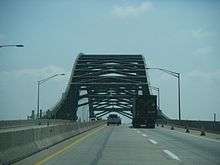Delaware River–Turnpike Toll Bridge
| Delaware River–Turnpike Toll Bridge | |
|---|---|
 Delaware River Turnpike Bridge from the east bank of the Delaware River | |
| Coordinates | 40°07′01″N 74°49′50″W / 40.11694°N 74.83056°WCoordinates: 40°07′01″N 74°49′50″W / 40.11694°N 74.83056°W |
| Carries |
4 lanes of |
| Crosses | Delaware River |
| Locale |
Bristol Township, Pennsylvania and Burlington Township, New Jersey |
| Official name | Delaware River–Turnpike Toll Bridge |
| Other name(s) | Delaware River Bridge |
| Maintained by | Pennsylvania Turnpike Commission and New Jersey Turnpike Authority |
| ID number | 097276990359000 |
| Characteristics | |
| Design | Steel Arch-Shaped Continuous Through Truss Bridge |
| Total length | 6,751 ft (2,058 m) |
| Width | 90 ft (27 m) |
| Longest span | 682 ft (208 m) |
| Clearance below | 135 ft (41 m) |
| History | |
| Construction begin | January 15, 1954 |
| Opened | May 25, 1956 |
| Statistics | |
| Daily traffic | 30,390 (2000) |
| Toll |
Westbound (via NJ Turnpike exit 6A): $1.95 cash/E-ZPass $1.45 E-ZPass off-peak[1] |
The Delaware River–Turnpike Toll Bridge is a four-lane steel arch-shaped continuous truss bridge that connects the Pennsylvania Turnpike's East-West Mainline with the main trunk of the New Jersey Turnpike, via the Pearl Harbor Memorial Extension (formerly known as the Pennsylvania Extension). The bridge crosses the Delaware River, connecting Bristol Township, Pennsylvania and Burlington Township, New Jersey.
History
The bridge was built by both the Pennsylvania Turnpike Commission (PTC) and the New Jersey Turnpike Authority (NJTA) when the PTC completed the "Delaware River Extension" of the Pennsylvania Turnpike between Valley Forge and Bristol Township in 1955, while the NJTA built the 118-mile (190 km) NJ Turnpike between Penns Grove and Ridgefield Park between 1950 and 1952. While the Pennsylvania Turnpike itself predates its New Jersey counterpart by over 10 years (the original Irwin-Carlisle section opened in 1940), the expansion of the Pennsylvania Turnpike to a cross-state highway was put on hold for the duration of World War II.
Starting with the upsurge of automobile traffic in 1946, the Pennsylvania Turnpike expanded from the original 110-mile (180 km) highway west from Irwin to the Ohio border and east from Carlisle to Valley Forge. At the same time, New Jersey, lacking a high-speed corridor, undertook the building of the New Jersey Turnpike under the auspices of then-Governor of New Jersey Alfred E. Driscoll. In order to provide a high-speed, low-interruption route from New York City to the Midwest, both the PTC and the NJTA undertook the building of the Delaware River-Turnpike Toll Bridge (known locally as the "Turnpike Connector Bridge") to connect the two highways. A local AAA chapter spearheaded a failed effort to have the bridge named after William Penn.
To maintain the "high-speed, low-interruption" characteristics ("low interruption" referring to the few stops needed to pay toll or fuel up at the numerous full-service plazas on both routes), the new bridge was designed from the beginning as a high-level crossing. This sharply contrasts with the Tacony–Palmyra Bridge and the Burlington–Bristol Bridge located downstream as they are both drawbridges, and are subject to frequent openings to allow large ships up and down stream (all other bridges downstream from the Delaware River-Turnpike Toll Bridge are high level crossings).
Maintenance

In addition, the Turnpike Connector bridge is operated jointly by the PTC and the NJTA, neither of which is subject to the interstate rules and regulations of the other dual-state authorities — Delaware River Port Authority (DRPA); Burlington County Bridge Commission (BCBC); Delaware River and Bay Authority (DRBA); and the Delaware River Joint Toll Bridge Commission (DRJTBC) — which operate nearly all other bridges across the Delaware River (except for the Dingman's Ferry Bridge, which is privately owned). Each state is responsible for its half of the bridge up to the state line (as evident in a recent redecking project in which the PTC redecked its half of the bridge with fresh concrete first, with the NJTA following later in a separate project).
In 2011, the NJTA and PTC undertook an investigation of the existing suspender system on the main span. Based on destructive testing of suspenders from the similar Newark Bay Bridge, consultants HNTB determined that the Delaware River bridge's suspenders had limited remaining service life and needed to be replaced. At each suspender location, the load from each original 4-inch-diameter (10 cm) wire rope was transferred into a set of four new 2-inch-diameter (5.1 cm) wire ropes, after which the original suspender was cut. The project was completed in August 2013.[2]
Future construction
With ongoing plans to build a direct interchange between the Pennsylvania Turnpike and Interstate 95 near Bristol Township, both the PTC and the NJTA have started upgrading the infrastructure of the approaches to the Turnpike connector bridge, as well as the bridge itself. The centerpiece for the upgrade will be the building of a second, paralleling span which will be identical in appearance to the original 1956 span, similar in nature to the Delaware Memorial Bridge. Other improvements completed or slated for the I-95 rerouting (due to the cancellation of the Somerset Freeway in 1982) are as follows:
Pennsylvania
- Widening of the Turnpike between the Bensalem (formerly Philadelphia) and Delaware River Bridge interchanges.
- Building of a new mainline (Neshaminy) toll barrier east of the Bensalem interchange and the conversion of the Delaware River Bridge toll plaza to an all-cash westbound-only (southbound I-95) facility. (COMPLETED)
- Removal of the toll plaza on the Delaware Valley interchange with the Turnpike and U.S. Route 13. (COMPLETED) This will allow both the new high-speed interchange with I-95 and the exit with U.S. 13 to be similar to the New Castle, Beaver Valley, and Cranberry exits in western Pennsylvania.
- Installation of variable message signs and other infrastructure improvements (drainage, emergency access, etc., as they have changed little since 1955).
New Jersey
- Construction of a new Exit 6A and Exit 6 toll gate (Florence) with high-speed E-ZPass only lanes (COMPLETED)
- Widening of the Pearl Harbor Extension to six lanes (COMPLETED)
- Widening of the main New Jersey Turnpike trunk from Exit 6 (Mansfield) to Exit 8A (Monroe) from six lanes to a dual-dual configuration of 3-3-3-3 (COMPLETED)
These plans, which will occur between 2007 and 2014, will occur at the same time of the building of both the new interchange and the paralleling span itself. Once completed, the new span, along with the original span will carry up to six lanes of traffic with extra wide shoulders for emergency stops. According to documents released by the PTC, construction of the new span will not commence until after 2016.
See also
-
 Bridges portal
Bridges portal -
 Pennsylvania portal
Pennsylvania portal -
 New Jersey portal
New Jersey portal - List of crossings of the Delaware River
References
- ↑ "New Jersey Turnpike Class 1 Toll Rate Schedule" (PDF). New Jersey Turnpike Authority. Archived from the original (PDF) on February 26, 2007. Retrieved 2008-01-14.
- ↑ Schaefer, Richard; Zoli, Theodore P.; Tatoris, Ana (February 2014). "Switching Suspenders". Civil Engineering. American Society of Civil Engineers: 66–71, 78.
External links
| Wikimedia Commons has media related to Delaware River – Turnpike Toll Bridge. |
- PhillyRoads.com: Delaware River–Turnpike Toll Bridge
- Delaware River–Turnpike Toll Bridge at Structurae
